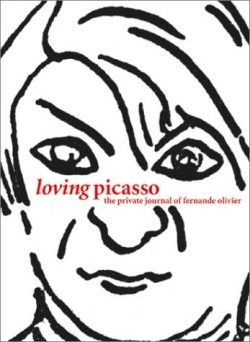Loving Picasso
The Private Journal of Fernande Olivier
Fernande Olivier, known mostly for being Picasso’s first major lover from 1905 until 1912, was a central figure in the Parisian art world of the early twentieth century. This version of her journal is everything an illustrated book can and should be; the pictures enhance her writing wonderfully.
One of the most impressive things about Loving Picasso is that the illustrations avoid focusing on the major painter in her life and instead focus on Fernande. Included are photos of the house and area where she grew up, sculptures she modeled for during her early years in the art world, her own paintings and sketches (one she did of Picasso is the cover art), in addition to Picasso’s sketches, paintings, and photographs of her. When Fernande describes the bohemian life she and her friends subscribed to, with frequent recouplings, drug use, and insistence on living outside the strictures of society, she might be describing a ‘60s commune in Berkeley, but the photos show the women still wearing long skirts and their hair up. It’s an interesting incongruity for the contemporary reader.
Fernande is a good writer providing taut and vivid descriptions of her life. Also included are some of her letters and selections from her memoirs. McCully’s biographical notes of the characters mentioned are invaluable in keeping track of the hundreds of famous artists who pass through Fernande’s life.
Fernande’s life was not easy. She was born to an unwed couple, and her parents foisted her off on an aunt and uncle who did not particularly cherish the child. At eighteen, Fernande was seduced and raped by the friend of a household maid, and her aunt forced her to marry the man.
When Fernande escaped her abuser, she was picked up by sculptor Laurent Debienne, who took her back to his studio to model for him. Thus did Fernande enter the world of the artists. She proved to be a very popular model, working for painters Fernand-Anne Cormon and Edouard Sain, and sculptor François Sicard, among others. She meets the painter Raoul Dufy when he is still a student and they briefly become lovers.
In the spring of 1904, Fernande writes: “There’s a Spanish painter who has just come to live in our building and seems very taken with me.” Fernande likes Picasso as a friend, but not as a lover: “Poor Pablo is very unhappy… He writes me desperate letters in a French that is highly imaginative and quite barbaric.” How wonderful to find out that one of the greatest artists of the twentieth century suffered unrequited love like so many others!
Suddenly one night—with the help of opium, it seems—Fernande falls in love with the Spaniard. The opium scene is one of the best in the book and most vividly illustrates Fernande’s skill as a writer. She describes the details of how to smoke opium using the “tiny, mysterious lamp; the long bamboo with its ivory end decorated with enamels and chased silver plaques and its octagonal clay bowl with that treacherous, sensitive, acid, and penetrating reek of opium.” After moving in with Picasso, Fernande’s journal entries are more vivacious and happier.
The relationship with Picasso has its drawbacks. He’s wildly jealous and won’t let her out of the house, even going so far as to lock her into the room when he’s not there. They are desperately poor, but Picasso forces her to quit modeling to satisfy his jealousy.
Fernande offers intimate glances at her lover’s art and their set of creative and to-be-famous friends: Max Jacob, Guillaume Apollinaire, André and Alice Derain, Leo and Gertrude Stein. Fernande treats historic developments in Picasso’s work as everyday events in her journal, because to her, they were. Regarding the passing of his Blue Period: “The blue figures, reminiscent of El Greco, that I loved so much have been covered with delicate, sensitive paintings of acrobats.” In sections of her memoir, she discusses the influence of African painting on Picasso’s work, the development of Cubism, and his collaboration with Georges Braque.
Their relationship ends after Picasso has achieved a measure of success. In the epilogue Picasso scholar Richardson says that the painter was ready to settle down, and Fernande was too bohemian to be a wife. Besides, she had never gotten a divorce from her husband. In writing about her years with Picasso, however, she created what Richardson says the artist called “the only really authentic picture” of the art world years when they were together.
Reviewed by
Celeste Sollod
Disclosure: This article is not an endorsement, but a review. The publisher of this book provided free copies of the book to have their book reviewed by a professional reviewer. No fee was paid by the publisher for this review. Foreword Reviews only recommends books that we love. Foreword Magazine, Inc. is disclosing this in accordance with the Federal Trade Commission’s 16 CFR, Part 255.

